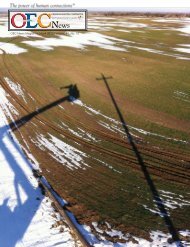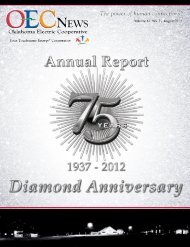February - Oklahoma Electric Cooperative
February - Oklahoma Electric Cooperative
February - Oklahoma Electric Cooperative
You also want an ePaper? Increase the reach of your titles
YUMPU automatically turns print PDFs into web optimized ePapers that Google loves.
Are All Fires the Same?<br />
By Kelly Trapnell<br />
Safety<br />
Where there’s smoke, there’s<br />
fire. And while all blazes may<br />
look the same, fires should not<br />
be treated equally.<br />
According to the Federal<br />
Emergency Management<br />
Agency, more than 26,000<br />
electrical home fires result in<br />
property damage, injuries and/or<br />
death every year. Remember this<br />
acronym F.I.R.E for electrical<br />
safety:<br />
Find the source before<br />
it starts. Old or faulty<br />
wiring often emerges<br />
as the main culprit in causing<br />
electrical fires. In electrical<br />
fires, heat from wiring or an<br />
overloaded system can provide<br />
the strike that leads to a fire. But<br />
there are often signs before a fire<br />
even starts.<br />
Investigate the signs. If<br />
you notice flickering lights,<br />
recurring trips in a circuit<br />
breaker, or the tell-tale sizzling<br />
sound around wiring and hot<br />
light switches, call a qualified<br />
electrician. These may indicate<br />
an imminent fire hazard.<br />
Remedy the problem.<br />
If you have any signs of<br />
a pending fire or have<br />
worries about old wiring, contact<br />
a professional electrician. Other<br />
precautions include:<br />
☞☞<br />
Routinely check appliances<br />
for signs of wear and tear or<br />
overheating.<br />
<strong>Electric</strong>al Fire Culprits<br />
About 26,000 household electrical fires occur in the U.S. every<br />
year. Following are the top five pieces of equipment that ignite<br />
residential electrical fires.<br />
Cord, Plug<br />
Heating<br />
Other<br />
Lamp, Lighting<br />
11.3%<br />
9.9%<br />
8.5%<br />
☞☞<br />
Use correct wattage bulbs to<br />
prevent overheating fixtures.<br />
☞☞<br />
Avoid using damaged cords<br />
or running cords under rugs.<br />
☞☞<br />
Do not overload outlets or<br />
extension cords.<br />
☞☞<br />
Do not use appliances in wet<br />
areas.<br />
Exit the Building and<br />
Learn to Extinguish<br />
Properly. If you are faced<br />
with an electrical fire, call 911<br />
immediately and have everyone<br />
exit the building. If you feel you<br />
must face a small fire, know the<br />
proper way to approach it.<br />
☞☞<br />
Never use water on an<br />
electrical fire. Water conducts<br />
electricity, so it will not smother<br />
the fire and may lead to<br />
electrocution.<br />
☞☞<br />
If the circuit breaker does<br />
23.5%<br />
46.8%<br />
<strong>Electric</strong>al Wiring<br />
0 10% 20% 30% 40% 50%<br />
Source: U.S. Fire Administration National Fire Incident Reporting System; Residential<br />
Building <strong>Electric</strong>al Fires Volume 8, Issue 2; 2010 USFA Fire Estimate Summary<br />
not trip in the area on fire, shut<br />
off the main breaker to the house<br />
if possible. Be sure to approach<br />
the breaker only if the fire is not<br />
nearby and if your hands are dry.<br />
☞☞<br />
Never use a Class A<br />
extinguisher on an electrical<br />
fire. Use a Class C or a multipurpose<br />
ABC model. If there<br />
is no extinguisher available or<br />
the class of extinguisher is not<br />
known, baking soda may help<br />
smother the flames.<br />
☞☞<br />
Again, if the fire is not<br />
quickly extinguished, exit the<br />
building.<br />
Even though the source and<br />
treatment of fires may differ,<br />
they produce the same results.<br />
You are no match for the force of<br />
a house fire—learn F.I.R.E. and<br />
protect yourself.<br />
Sources: U.S. Fire Administration, <strong>Electric</strong>al Safety Foundation International, National Fire Incident Reporting System.<br />
Kelly Trapnell writes on safety and energy efficiency issues for the National Rural <strong>Electric</strong> <strong>Cooperative</strong> Association.<br />
News Magazine 11












